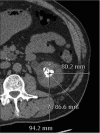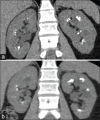Advances in CT imaging for urolithiasis
- PMID: 26166961
- PMCID: PMC4495492
- DOI: 10.4103/0970-1591.156924
Advances in CT imaging for urolithiasis
Abstract
Urolithiasis is a common disease with increasing prevalence worldwide and a lifetime-estimated recurrence risk of over 50%. Imaging plays a critical role in the initial diagnosis, follow-up and urological management of urinary tract stone disease. Unenhanced helical computed tomography (CT) is highly sensitive (>95%) and specific (>96%) in the diagnosis of urolithiasis and is the imaging investigation of choice for the initial assessment of patients with suspected urolithiasis. The emergence of multi-detector CT (MDCT) and technological innovations in CT such as dual-energy CT (DECT) has widened the scope of MDCT in the stone disease management from initial diagnosis to encompass treatment planning and monitoring of treatment success. DECT has been shown to enhance pre-treatment characterization of stone composition in comparison with conventional MDCT and is being increasingly used. Although CT-related radiation dose exposure remains a valid concern, the use of low-dose MDCT protocols and integration of newer iterative reconstruction algorithms into routine CT practice has resulted in a substantial decrease in ionizing radiation exposure. In this review article, our intent is to discuss the role of MDCT in the diagnosis and post-treatment evaluation of urolithiasis and review the impact of emerging CT technologies such as dual energy in clinical practice.
Keywords: Advances; computed tomography; urolithiasis.
Conflict of interest statement
Figures






References
-
- Neisius A, Preminger GM. Stones in 2012: Epidemiology, prevention and redefining therapeutic standards. Nat Rev Urol. 2013;10:75–7. - PubMed
-
- Bartoletti R, Cai T, Mondaini N, Melone F, Travaglini F, Carini M, et al. Epidemiology and risk factors in urolithiasis. Urol Int. 2007;79(Suppl 1):3–7. - PubMed
-
- Seitz C, Fajkovic H. Epidemiological gender-specific aspects in urolithiasis. World J Urol. 2013;31:1087–92. - PubMed
-
- Smith RC, Verga M, McCarthy S, Rosenfield AT. Diagnosis of acute flank pain: Value of unenhanced helical CT. AJR Am J Roentgenol. 1996;166:97–101. - PubMed
Publication types
LinkOut - more resources
Full Text Sources
Other Literature Sources

